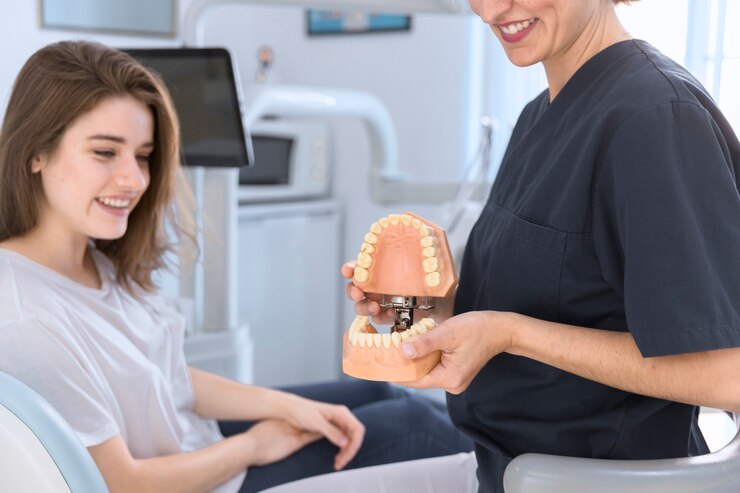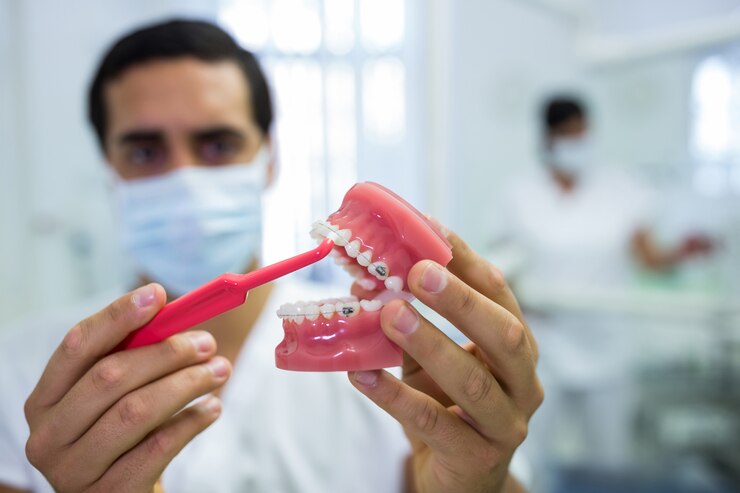Dental Crowns For Cosmetic Enhancements: What You Should Know
Dental crowns stand at the crossroads of cosmetic enhancement and dental health, offering a solution that not only improves oral functionality but also transforms smiles. This convergence of health and aesthetics marks a pivotal moment for individuals looking to enhance their dental appearance without compromising on quality or durability.
That said, this guide will delve into the essential aspects of using dental crowns for cosmetic purposes, from its definition, the choice of materials, its benefits, and the intricacies of the procedure itself.
What Are Dental Crowns?

Dental crowns are custom-fitted tooth prosthetics used to cover or ‘cap’ a damaged tooth. Unlike removable devices such as dentures, crowns are cemented onto teeth or implants, offering a permanent solution that improves the appearance, shape, and alignment of one’s teeth. Furthermore, with advancements in dental technology, such as restoring tooth via Cerec, crowns now look more natural. They are more durable than ever, making them a preferred option for cosmetic enhancements as well as for strengthening damaged teeth.
Types Of Materials Used In Dental Crowns
Various materials, each with unique benefits and considerations, can craft dental crowns. Factors such as the tooth’s location, the patient’s bite, aesthetic preferences, and budget influence the choice of material. Here are the most common types of materials used in dental crowns:
- Porcelain or Ceramic: These materials stand out for their capability to replicate the natural transparency and color of teeth, rendering them a superior option for front teeth restorations. Porcelain can be fused to a metal base for added strength or used alone for a highly aesthetic crown. They are suitable for people with metal allergies.
- Metal Alloys: These include gold, palladium, nickel, or chromium. Metal crowns are incredibly durable and withstand biting and chewing forces well, making them ideal for molars. While not as cosmetically appealing as porcelain or ceramic, they are highly functional and have a long lifespan.
- Porcelain Fused to Metal (PFM): This type combines a metal base for strength with a porcelain exterior for a natural appearance. While PFM crowns offer a good balance between durability and aesthetics, the metal underlying the porcelain can sometimes show through as a dark line near the gum line.
- All-Resin: These crowns are made from a type of plastic dental resin. They are less expensive than other types but also less durable, more prone to fractures, and tend to wear down over time.
- Zirconia: This is a relatively new material that combines the strength of metal with the aesthetics of porcelain crowns. Zirconia crowns are made from zirconium dioxide, a strong, durable material that matches the color of natural teeth closely. They are suitable for both front and back teeth and are a popular choice due to their excellent durability and aesthetic appearance.
- Lithium Disilicate (E-Max): This is a type of all-ceramic crown made from lithium disilicate glass ceramic, known for its excellent strength and aesthetic qualities. E-Max crowns are particularly suited for front teeth due to their natural clarity and color-matching capabilities.
Each material has its own set of advantages and limitations, and the right choice depends on the individual’s specific needs, dental health, and cosmetic preferences.
The Impact Of Dental Crowns On Oral Health

The impact of dental crowns on oral health is predominantly positive, offering both functional and aesthetic benefits. Dental crowns play a crucial role in dental restoration and cosmetic dentistry, helping to improve the overall health of your mouth in several ways. Here’s how dental crowns can impact oral health:
Protection of Damaged Teeth
Dental crowns offer a strong, protective covering for teeth that are weakened, decayed, or have undergone significant restorative procedures, such as root canal therapy. By encapsulating the entire visible portion of the tooth above the gum line, crowns prevent further tooth decay, cracking, or breakage, thereby preserving the tooth’s structure and functionality.
Restoration of Tooth Function
Crowns restore the shape, size, strength, and appearance of teeth, enabling normal function. This means you can chew and bite without pain or discomfort, which is vital for proper digestion and overall health. They help distribute the force of biting evenly, preventing further damage to the rest of your teeth.
Improvement in Aesthetic Appearance
For individuals with stained, misshapen, or poorly aligned teeth, dental crowns offer a cosmetic solution that can dramatically enhance the appearance of their smile. This boost in confidence can have a significant positive impact on mental health and social interactions.
Contribution to Overall Oral Health
By restoring damaged teeth, dental crowns help maintain the integrity of the dental arch and prevent issues related to missing or severely damaged teeth, such as jawbone deterioration and misalignment of surrounding teeth.
Properly aligned and healthy teeth also contribute to better oral hygiene, as they are easier to clean and maintain, reducing the risk of gum disease and tooth decay.
The Process Of Getting Dental Crowns
Typically, completing this procedure requires two or more visits to the dentist, depending on the patient’s specific circumstances and requirements. Here is a step-by-step overview of the process:
1. Initial Consultation
The journey toward getting a dental crown begins with an initial consultation, a crucial step where the dentist assesses the health and condition of your teeth. This assessment often involves taking X-rays to examine the roots of the tooth in question and the surrounding bone structure to ensure a crown is the appropriate solution.
During this visit, you and your dentist will discuss the various materials available for the crown, such as porcelain, ceramic, metal, or composite resin.
2. Tooth Preparation
The preparation of the tooth is a meticulous process that starts with administering local anesthesia to numb the tooth and surrounding area, ensuring a pain-free experience. The dentist then reshapes the tooth, trimming down its size to accommodate the crown adequately.
The dentist carefully performs this reshaping to preserve as much of the natural tooth structure as possible while creating enough space for the crown material. After reshaping, the dentist takes an impression of the tooth using either digital scanning technology or traditional dental putty. This impression is crucial because it serves as the blueprint for crafting the crown to fit your tooth precisely.
3. Crown Fabrication
After taking the impression, the dentist sends it to a dental laboratory where technicians fabricate the actual crown. This stage demands precision and attention to detail because the crown must fit snugly over the prepared tooth and match the color and appearance of your natural teeth if made from porcelain or ceramic.
The fabrication process can take several weeks, during which the dental technicians meticulously craft the crown to meet the exact specifications provided by the dentist. Once completed, the crown undergoes a final quality check by the dentist to ensure its fit and color are perfect before the final placement.
4. Final Placement
The final placement of the crown is a moment of transformation, where the temporary crown is removed, and the permanent one is carefully fitted. This stage allows the dentist to make any necessary adjustments to ensure the crown fits comfortably and aligns correctly with your bite.
It’s essential that the crown not only looks natural but also feels right in your mouth. Once both you and the dentist are satisfied with the fit and appearance, the crown is cemented into place, securing it over your tooth.
5. Aftercare and Follow-Up
Proper aftercare is vital for the longevity of your new crown. After the placement, your dentist will provide you with detailed care instructions, including how to brush and floss around the crown, as well as any temporary dietary restrictions to prevent damage to the crown before it fully sets.
Regular follow-up visits may be recommended to monitor the crown and the underlying tooth health, ensuring your mouth remains healthy and your crown stays in great condition.
Conclusion
As dental technology advances, the options for cosmetic dental enhancements, including crowns, become more sophisticated and accessible, providing even more excellent opportunities for individuals to achieve the smile they’ve always desired.
Therefore, armed with the correct information and guided by professional dental advice, deciding to opt for a dental crown can be a transformative step toward not just a more beautiful smile but a healthier, more confident you.
Read Also:



